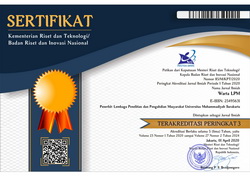Pemberdayaan Masyarakat Padukuhan Malangrejo dalam Pemanfaatan Pewarna Alami Makanan
DOI:
https://doi.org/10.23917/warta.v27i1.1584Keywords:
Pendampingan, kelompok wanita tani, Pewarna alami makananAbstract
The Community Service Activities for the Independent Campus Learning Program (PkM MBKM), which involves lecturers and students has been done. The program aims to empower the people of Padukuhan Malangrejo, Wedomartani, Ngemplak Sleman, regarding the use of natural dyes for healthy food products. The targets during this program were 14 Women Farmers Group (KWT) participants, 10 elementary school students and 10 teenagers. In this course, we did the socialization of the activities, increasing the community literacy about natural food coloring and its benefits for health, by using the learning modules for children, adolescents and members of Women Farmer Groups (KWT). The training was carried out on the production of natural dyes that can be stored, as well as the creation of colorful food and drink recipes. Evaluation of literacy activities is assessed from understanding the material at the beginning (pre-test) and end (post-test) of the activity. Food products with natural dyes were organoleptically tested in communities outside Malangrejo. Other activities include assistance in the production of BiTel pudding (beetroot and butterfly pea coloring) with limited marketing, obtaining a Hygiene and Sanitation Certificate (SLHS) from the Health Service, Sleman. Activities to plant natural food dyes are carried out in yards and less productive land. Planting methods were adjusted to the type of plant, both horizontally and vertically. The results of the activity showed an increase in community participation and understanding of the benefits of natural food coloring (16.4%), increased literacy in the youth group (4%), KWT participants (2.9%), while for elementary school students there were 40% of participants who got a score of 100 %. This activity also gave rise to Micro, Small and Medium Enterprises (MSMEs or UMKM) which produce food with natural dyes, as well as the enthusiasm of KWT Malangrejo members in using their home gardens to produce natural food dyes. The MBKM PkM program for village development, which was implemented in Padukuhan Malangrejo, was well appreciated by the community and the Wedomartani Village leader, and hopefully the programs will continue in the following year.
Downloads
References
Azima, A. S., Noriham, A., & Manshoor, N. (2017). Phenolics, antioxidants and color properties of aqueous pigmented plant extracts: Ardisia colorata var. elliptica, Clitoria ternatea, Garcinia mangostana and Syzygium cumini. Journal of Functional Foods, 38: 232-241.
Babarykin, D., Smirnova, G., Pundinsh, I., Vasiljeva, S., Krumina, G., & Agejchenko, V. (2019). Red beet (Beta vulgaris) impact on human health. Journal of biosciences and medicines, 7(3): 61-79.
Chusak, C., Thilavech, T., Henry, C. J. & Adisakwattana, S. (2018). Acute effect of Clitoria ternatea flower beverage on glycemic response and antioxidant capacity in healthy subjects: a randomized crossover trial. BMC Complementary and Alternative Medicine, 18(6): 1-18.
Handayani, R., & Larasati, H. Y., (2018). Identifikasi Pewarna Sintetis pada Produk Olahan Bunga Rosella (Hibiscus sabdariffa) dengan Metode Kromatografi Lapis Tipis. Anterior Jurnal, 17(2): 130-135.
Indrasti, D., Andarwulan, N., Hari Purnomo, E., & Wulandari, N. (2019). Suji Leaf Chlorophyll: Potential and Challenges as Natural Colorant. Jurnal Ilmu Pertanian Indonesia, 24(2): 109–116. https://doi.org/10.18343/jipi.24.2.109
Kanner, J., Harel, S., & Granit, R. (2001). Betalains a new class of dietary cationized antioxidants. Journal of Agricultural and Food chemistry, 49(11): 5178-5185.
Khairuddin, Baciang, J. N., Indriani, & Inda, N. I. (2020). Ekstraksi dan Uji Stabilitas Zat Warna Alami dari Bayam Merah (Alternanthera amoena Voss). KOVALEN: Jurnal Riset Kimia, 6(3): 212-217.
Lubis, M. S., Yuniarti, R., dan Ariandi. 2020. Pemanfaatan pewarna alami kulit buah naga merah serta aplikasinya pada makanan. Jurnal Amaliah, 4(2): 110-114.
Mohamad, M. F., Dailin, D. J., Gomaa, S. E., Nurjayadi, M., & El Enshasy, H., (2019). Natural colorant for food: a healthy alternative. Int J Sci Technol Res, 8: 3161-3166.
Nabila, F. S., Radhityaningtyas, D., Yurisna, V. C., Listyaningrum, F., dan Aini, N. 2022. Potensi Bunga Telang (Clitopria ternatea L.) Sebagai Antibakteri pada Produk Pangan. Jurnal Teknologi dan Industri Pangan UNISRI. 7(1): 68-77.
Nemzer, B., Pietrzkowski, Z., Spórna, A., Stalica, P., Thresher, W., Michałowski, T., & Wybraniec, S. (2011). Betalainic and nutritional profiles of pigment-enriched red beet root (Beta vulgaris L.) dried extracts. Food chemistry, 127(1): 42-53.
Novais, C., Molina, A. K., Abreu, R. M. V., Buelga, C. S., Ferreira, I. C. F. R., Pereira, C., and Barros, L. 2022. Natural food colorants and preservatives: a review, a demand and challenge. Journal of Agricultural and Food Chemistry , 70: 2789-2805.
Nurchasanah. 2021. Peran kelompok Wanita Tani Srikandi dalam pemanfaatan pekarangan terbatas di daerah perkotaan. Journal of Society and Continuing Education, 2(1).
Oguis, G.K., Gilding, E.K., Jackson, M.A., and Craik, D.J. (2019). Butterfly Pea (Clitoria ternatea), a Cyclotide-Bearing Plant With Applications in Agriculture and Medicine. Front. Plant Sci, 10(645): 1-23.
Pasukamonset, P., Pumalee, T., Sanguansuk, N., Chumyen, C., Wongvasu, P., Adisakwattana, S., & Ngamukote, S. (2018). Physicochemical, antioxidant and sensory characteristics of sponge cakes fortified with Clitoria ternatea extract. Journal of food science and technology, 55(8): 2881-2889.
Rinawati, Sembiring, Z., Simanjuntak, W., dan Rosa, E. 2021. Pembuatan serbuk pewarna alami dari berbagai tanaman tropis dengan metode oven drying. Jurnal Pengabdian Kepada Masyarakat Tabikpun, 2(2): 101-108.
Saati, E. A., Wachid, M., Nurhakim, M., Winarsih, S., & Rohman, M. L. A., (2019). Pigmen Sebagai Zat Pewarna dan Antioksidan Alami Identifikasi Pigmen Bunga, Pembuatan Produknya serta Penggunaannya (Vol. 1). UMM Press. p: 3.
Setiawan, M. A. W., Nugroho, E. K., & Lestario, L. N., (2015). Ekstraksi betasianin dari kulit umbi bit (Beta vulgaris) sebagai pewarna alami. Agric, 27(1): 38-43.
Setiyoko, A., Putri, S. K. ., & Casmi, E. (2023). Diversifikasi Olahan Ubi Ungu untuk Meningkatkan Daya Saing Produk Pangan di Sleman. Warta LPM, 26(4): 412–421.
Subhan, Arfi, F., Ummah, A. (2019). Uji Kualitatif Zat Pewarna Sintetis pada Jajanan Makanan Daerah Ketapang Kota Banda Aceh. AMINA. 1(2): 67-71.
Suprihatin, T., Rahayu, S., Rifa'i, M., & Widyarti, S. (2020). Senyawa pada serbuk rimpang kunyit (Curcuma longa L.) yang berpotensi sebagai antioksidan. Buletin Anatomi dan Fisiologi, 5(1): 35-42.
Tama, J. B., Kumalaningsih, S., & Mulyadi, A. F. (2014). Studi pembuatan bubuk pewarna alami dari daun suji (Pleomele angustifolia NE Br.). kajian konsentrasi maltodekstrin dan MgCO3. Industria: Jurnal Teknologi dan Manajemen Agroindustri, 3(2): 73-82.
Tesoriere, L., Allegra, M., Gentile, C., & Livrea, M. A. (2009). Betacyanins as phenol antioxidants. Chemistry and mechanistic aspects of the lipoperoxyl radical-scavenging activity in solution and liposomes. Free Radical Research, 43(8): 706-717.
Downloads
Submitted
Accepted
Published
How to Cite
Issue
Section
License
Copyright (c) 2024 Warta LPM

This work is licensed under a Creative Commons Attribution 4.0 International License.















